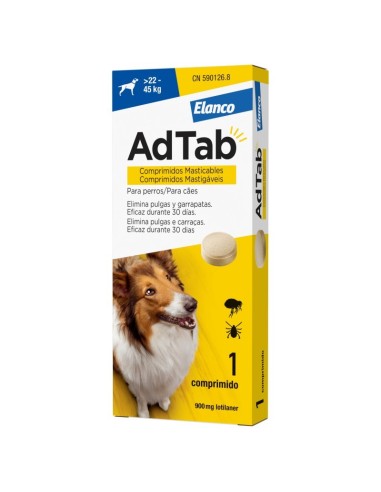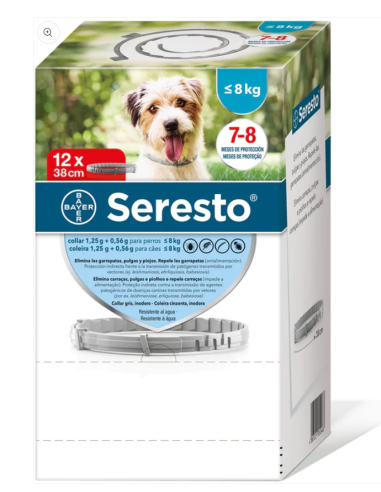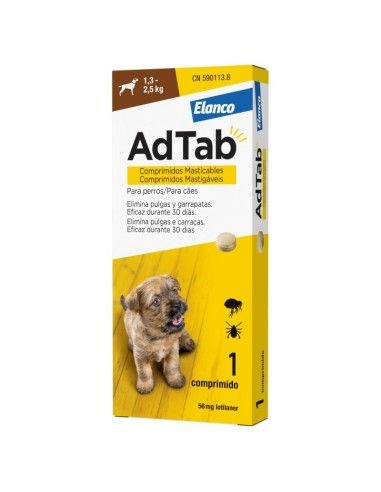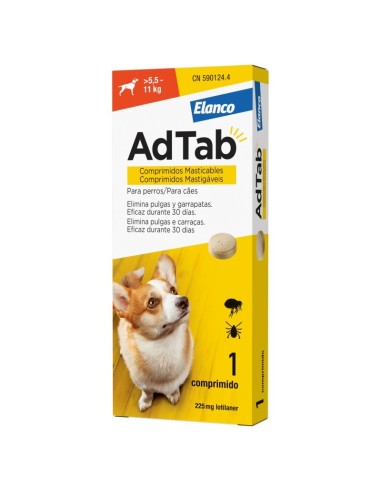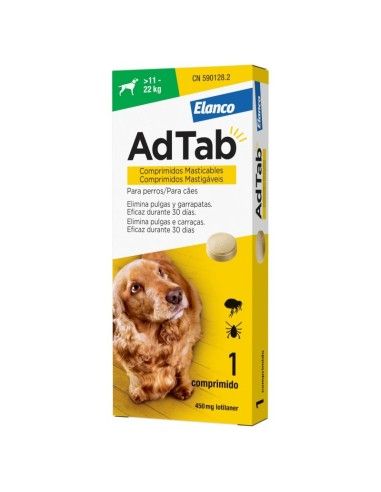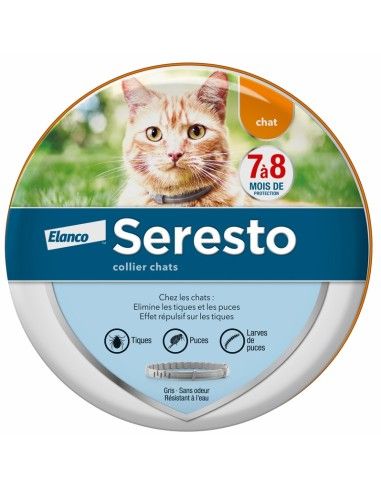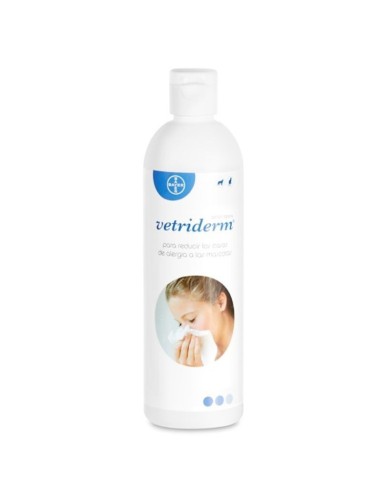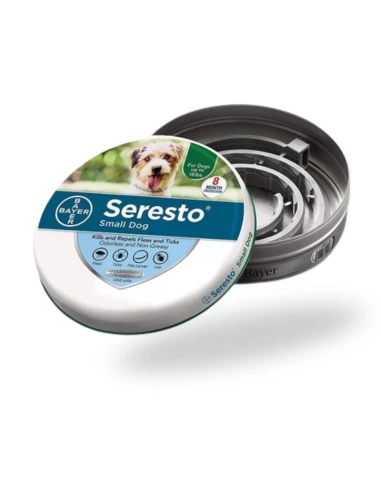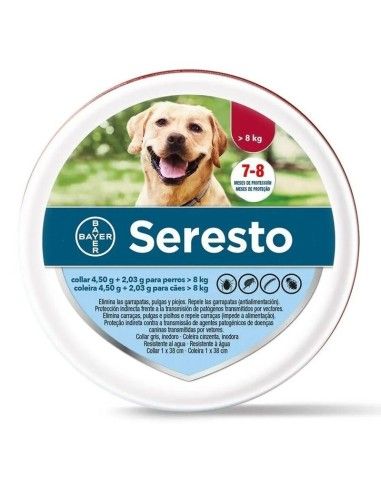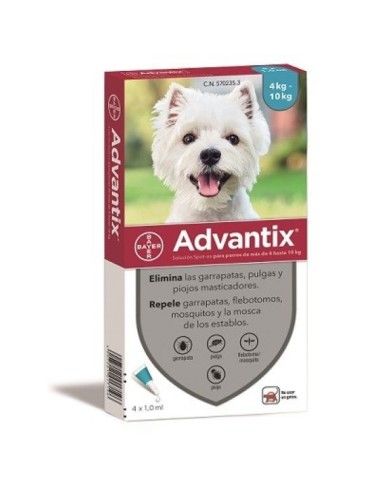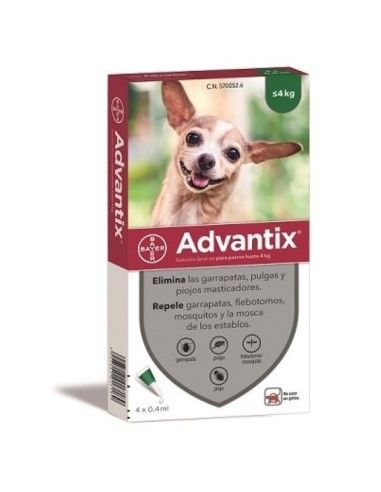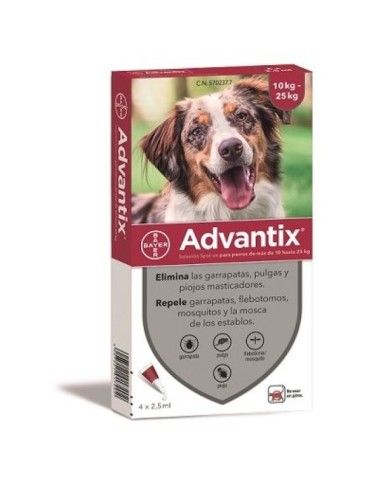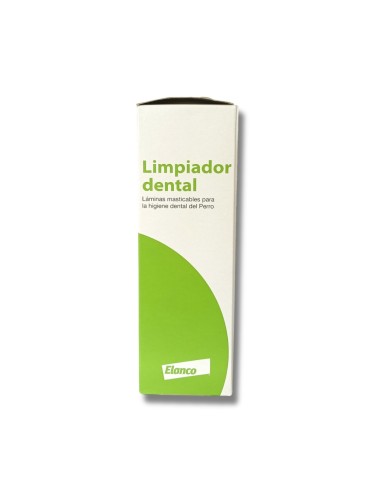
Collar SERESTO para Gatos, pack clinico de 12 unidades
Seresto is a collar designed with a secure closure mechanism, it is water resistant and odorless.
An ectoparasiticide belonging to the group of chloronicotinyl compounds.
It has Imidacloprid which is active against the larval stages of fleas, adult fleas and lice.
Efficacy against fleas (Ctenocephalides felis and Ctenocephalides canis) begins within 48 hours of collar application.
Imidacloprid has a high affinity for nicotinergic acetylcholine receptors in the posinaptic region of the central nervous system (CNS) of fleas.
The resulting inhibition of cholinergic transmission in insects causes paralysis and death.
In mammals, imidacloprid has virtually no effect on the CNS due to the weak nature of the interaction with nicotinergic receptors and poor penetration across the blood-brain barrier.
Imidacloprid has minimal pharmacological activity in mammals.









PHARMACOLOGICAL PROPERTIES
Imidacloprid is an ectoparasiticide belonging to the group of chloronicotinyl compounds. Chemically, it can be classified as a chloronicotinyl nitroguanidine. Imidacloprid is active against the larval stages of fleas, adult fleas and lice. Efficacy against fleas (Ctenocephalides felis and Ctenocephalides canis) begins within 48 hours of collar application.
In addition to the indications mentioned in the Indications section, activity against the flea Pulex irritans has been demonstrated.
Imidacloprid has a high affinity for nicotinergic acetylcholine receptors in the posinaptic region of the central nervous system (CNS) of fleas. The resulting inhibition of cholinergic transmission in insects causes paralysis and death. In mammals, imidacloprid has virtually no effect on the CNS due to the weak nature of the interaction with nicotinergic receptors and poor penetration across the blood-brain barrier. Imidacloprid has minimal pharmacological activity in mammals.
Flumethrin is an ectoparasiticide of the group of synthetic pyrethroids. Based on current knowledge, synthetic pyrethroids interfere with sodium channels in the cell membrane of neurons, resulting in delayed nerve fiber repolarization and parasite death. In studies conducted on the structure-activity relationship of some pyrethroids was observed an interference with receptors of a certain chiral conformation causing, consequently, a selective action on ectoparasites. No anticholinesterase activity has been observed in these compounds. Flumethrin provides the acaricidal activity of the veterinary medicinal product, thus preventing the formation of fertile eggs by its lethal effect on female ticks. On the other hand, in an in vitro study with Rhipicephalus sanguineus ticks exposed to a sublethal dose of 4 mg flumethrin/l it was observed that between 5 and 10 % of ticks laid eggs with altered appearance (wrinkled, dull and dry), which also indicates the sterilizing effect of flumethrin.
In addition to the tick species indicated in the Indications section, activity has been demonstrated against Ixodes hexagonus, I. scapularis and the non-European species Dermacentor variabilis and I. holocyclus (tick of Australian origin that causes paralysis).
The veterinary medicinal product has a repellent (antifeeding) effect against ticks by preventing repelled parasites from ingesting blood, thus indirectly helping to reduce the risk of contracting vector-borne canine diseases.
In addition to the pathogens indicated in the Indications section, an indirect protection against the transmission of Babesia canis canis (by the tick Dermacentor reticulatus) has been demonstrated in a laboratory study on day 28 of the treatment. Likewise, in another laboratory study, indirect protection against the transmission of Anaplasma phagocytophilum (by the tick Ixodes ricinus) has been shown 2 months after treatment. Consequently, the risk of transmission of diseases caused by these pathogens under the conditions of these studies is decreased.
Data from efficacy studies against sandflies (Phlebotomus perniciosus) showed variable repellent (antifeeding) efficacy ranging from 65 to 89% for 7-8 months after initial collar application. Data from 3 clinical studies conducted in endemic areas indicate a significant reduction in the risk of transmission of Leishmania infantum by sandflies in treated dogs compared to untreated dogs. Depending on the pressure of infection of sandflies, the efficacy in reducing the risk of leishmaniasis infection ranged from 88.3% to 100%.
Collars improve Sarcoptes scabiei infestation in pre-infested dogs and complete healing is achieved after 3 months.
Cats: In a laboratory study on a small number of cats, indirect protection against transmission of Cytauxzoon felis (by the tick Amblyomma americanum) has been demonstrated one month after treatment.
DIRECTIONS
Dogs and Cats:
- Prevention and treatment of flea infestation (Ctenocephalides felis, C. canis) for 7-8 months. It protects the immediate environment of the animal by inhibiting the development of flea larvae for 8 months.
- Seresto can be used as part of a treatment strategy for flea allergy dermatitis (APPD).
- The veterinary medicinal product is effective against tick infestations for 8 months due to its repellent (antifeeding) effect (Ixodes ricinus, Rhipicephalus sanguineus) and its acaricidal effect (parasite death) (Ixodes ricinus, Rhipicephalus sanguineus, Dermacentor reticulatus). It is effective against larvae, nymphs and adult ticks.
Ticks present on the dog before treatment may not die in the first 48 hours after collar application, so they could remain attached and visible. Therefore, it is recommended to remove existing ticks on the dog prior to the application of the collar. Prevention of new tick infestations is initiated during the first two days after collar application.
- The collar indirectly protects against the transmission of the pathogens Babesia canis vogeli and Ehrlichia canis by the tick Rhiphicephalus sanguineus and consequently, the risk of canine babesiosis and canine ehrlichiosis is reduced for 7 months.
- Reduction of the risk of infection by Leishmania infantum through transmission by sandflies up to 8 months.
- For the treatment of biting/chewing lice infestation (Trichodectes canis).
CONTRAINDICATIONS
• Do not treat puppies less than 7 weeks old or kittens less than 10 weeks old.
• Do not use in case of hypersensitivity to active substances or any excipient.
• In the absence of available data, the drug is not recommended in pregnant or lactating or cats.
ADVERSE REACTIONS
• Rarely, in the first few days after collar placement in animals that are not accustomed to wearing collars, slight changes in behavior may be observed including scratching at the application site. Make sure it's not too tight.
• Uncommonly in cats and rarely in dogs, mild reactions may occur at the application site such as pruritus, erythema and hair loss, which usually disappear in 1 or 2 weeks without the need to remove the collar.
• In isolated cases, temporary removal of the collar may be advisable until symptoms have disappeared.
• Very rarely in dogs and rarely in cats, application site reactions such as dermatitis, inflammation, eczema or lesions may occur. In these cases it is recommended to remove the collar.
• Rarely, in dogs, neurological signs such as ataxia, tremor and seizures may appear. In these cases, it is recommended to remove the collar.
• In addition, in dogs and cats, in rare cases, mild and transient reactions such as depression, changes in intake, salivation, vomiting and diarrhea may appear at first.
ROUTE OF ADMINISTRATION
Cutaneous use.
DOSAGE
Cats: 1 Seresto collar for Cats.
Dogs:
- Dogs = 8 kg: 1 Seresto collar for Dogs = 8 kg.
- Dogs >8 kg: 1 Seresto collar for Dogs >8 kg.
Tighten the collar loosely around the neck (leave a gap of about 2 fingers between the collar and neck). The animal must wear the collar continuously during the 8-month protection period. The collar should be removed at the end of treatment.
• Check the collar periodically and adjust it if necessary, especially in puppies and kittens with rapid growth.
• The collar is designed with a secure closure mechanism. In the unlikely event that a cat is trapped by the collar, the same strength of the animal is enough to widen and remove it quickly.
SPECIAL PRECAUTIONS
For animals:
• The drug is water resistant and continues to be effective even if the animal gets wet. However, intense and prolonged exposure to water or frequent use of shampoos should be avoided as the duration of activity may be diminished.
• An overdose is unlikely to occur and no signs of overdose are expected. In the unlikely event that the animal ingests a collar, mild gastrointestinal symptoms may occur.
For the person administering the medicine:
• Keep the bag containing the collar in the box until the time of use.
• Do not allow children to play with the collar or put it in their mouths.
• Collared animals should not sleep in bed with their owners, especially children.
• People with known hypersensitivity to collar components should avoid contact with the collar.
• Wash your hands with cold water after placing the collar.
REMARKS
No veterinary prescription.






